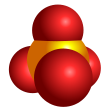Informatics Educational Institutions & Programs
Contents
| |||
| Names | |||
|---|---|---|---|
| IUPAC name
selenate
| |||
| Other names
selenate ion
| |||
| Identifiers | |||
3D model (JSmol)
|
|||
PubChem CID
|
|||
| UNII | |||
| |||
| Properties | |||
| SeO2− 4 | |||
| Conjugate acid | Hydrogen selenate | ||
Except where otherwise noted, data are given for materials in their standard state (at 25 °C [77 °F], 100 kPa).
| |||
The selenate ion is SeO2−
4.[1]
Selenates are analogous to sulfates and have similar chemistry. They are highly soluble in aqueous solutions at ambient temperatures.[2]
Unlike sulfate, selenate is a somewhat good oxidizer; it can be reduced to selenite or selenium.[3]
In strongly acidic conditions, the hydrogen selenate ion, HSeO−
4, is formed.[4] It corresponds to the selenic acid, H2SeO4, which is a strong acid and can in its concentrated form dissolve gold.[5]
The element selenium exhibits several valence states. Selenate is the least reduced, followed by selenite, and elemental selenium; selenide is even more reduced than elemental selenium.[6] The valence state is an important factor to the toxicity of selenium. Selenate is the form required by organisms that need selenium as a micronutrient. These organisms have the ability to acquire, metabolize and excrete selenium.[7] The level at which selenium becomes toxic varies from species to species and is related to other environmental factors like pH and alkalinity that influence the concentration of selenite over selenate.[8]
Selenate and other forms of selenium are highest in areas where ancient seas have evaporated. These areas are enriched in selenium and over millennia, biologic adaptation has occurred.[9]
References
- ^ Wickleder, Mathias S. (2005-01-01), Gschneidner, Karl A.; Bünzli, Jean-Claude G.; Pecharsky, Vitalij K. (eds.), Chapter 224 - Oxo-Selenates of rare earth elements, Handbook on the Physics and Chemistry of Rare Earths, vol. 35, Elsevier, pp. 45–105, doi:10.1016/S0168-1273(05)35002-1, ISBN 9780444520289, retrieved 2023-01-03
- ^ Jegadeesan, G.; Mondal, K.; Lalvani, S. B. (May 11, 2010). "Selenate removal from sulfate containing aqueous solutions". Environmental Technology. 26 (10): 1181–1187. doi:10.1080/09593332608618475. ISSN 0959-3330. PMID 16342540. S2CID 10304488.
- ^ Sarathchandra, S. U.; Watkinson, J. H. (1981-02-06). "Oxidation of elemental selenium to selenite by Bacillus megaterium". Science. 211 (4482): 600–601. Bibcode:1981Sci...211..600S. doi:10.1126/science.6779378. ISSN 0036-8075. PMID 6779378.
- ^ Kong, Linghao; Hu, Xingyun; Peng, Xianjia; Wang, Xianliang (2020-11-03). "Specific H2S Release from Thiosulfate Promoted by UV Irradiation for Removal of Arsenic and Heavy Metals from Strongly Acidic Wastewater". Environmental Science & Technology. 54 (21): 14076–14084. Bibcode:2020EnST...5414076K. doi:10.1021/acs.est.0c05166. ISSN 1520-5851. PMID 33058725. S2CID 222821717.
- ^ Plant, JA.; Bone, J.; Voulvoulis, N.; Kinniburgh, DG.; Smedley, PL.; Fordyce, FM.; Klinck, B. (2014-01-01), Holland, Heinrich D.; Turekian, Karl K. (eds.), "11.2 - Arsenic and Selenium", Treatise on Geochemistry (Second Edition), Oxford: Elsevier, pp. 13–57, ISBN 978-0-08-098300-4, retrieved 2023-01-03
- ^ Mangiapane, Erika; Pessione, Alessandro; Pessione, Enrica (2014). "Selenium and selenoproteins: an overview on different biological systems". Current Protein & Peptide Science. 15 (6): 598–607. doi:10.2174/1389203715666140608151134. hdl:2318/147957. ISSN 1875-5550. PMID 24910086.
- ^ Tan, Lea Chua; Nancharaiah, Yarlagadda V.; van Hullebusch, Eric D.; Lens, Piet N. L. (2016). "Selenium: environmental significance, pollution, and biological treatment technologies". Biotechnology Advances. 34 (5): 886–907. doi:10.1016/j.biotechadv.2016.05.005. ISSN 1873-1899. PMID 27235190.
- ^ Xie, Lingtian; Wu, Xing; Chen, Hongxing; Dong, Wu; Cazan, Alfy Morales; Klerks, Paul L. (2016). "A low level of dietary selenium has both beneficial and toxic effects and is protective against Cd-toxicity in the least killifish Heterandria formosa". Chemosphere. 161: 358–364. Bibcode:2016Chmsp.161..358X. doi:10.1016/j.chemosphere.2016.07.035. ISSN 1879-1298. PMID 27448316.
- ^ Domokos-Szabolcsy, Éva; Fári, Miklós; Márton, László; Czakó, Mihály; Veres, Szilvia; Elhawat, Nevien; Antal, Gabriella; El-Ramady, Hassan; Zsíros, Ottó; Garab, Győző; Alshaal, Tarek (2018-09-08). "Selenate tolerance and selenium hyperaccumulation in the monocot giant reed (Arundo donax), a biomass crop plant with phytoremediation potential". Environmental Science and Pollution Research International. 25 (31): 31368–31380. Bibcode:2018ESPR...2531368D. doi:10.1007/s11356-018-3127-3. ISSN 1614-7499. PMID 30196460. S2CID 52177009.



















